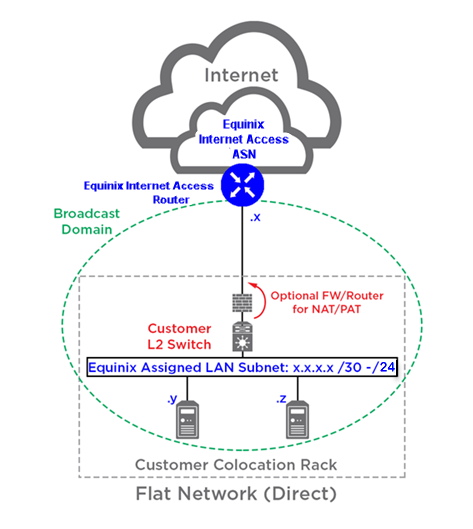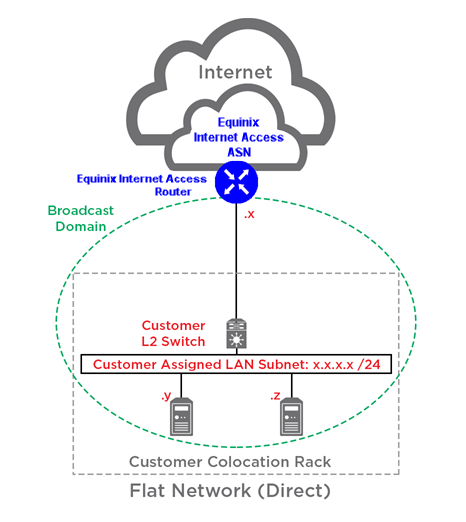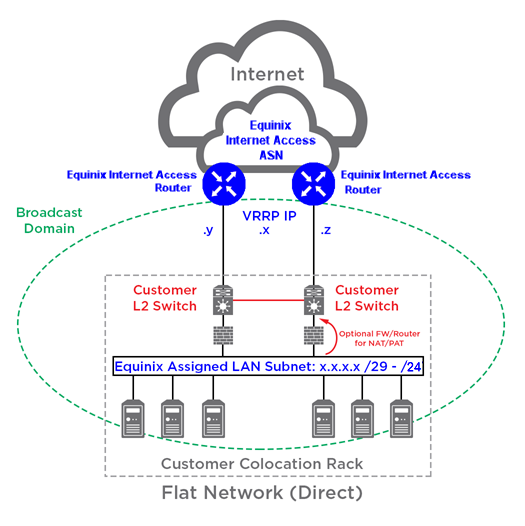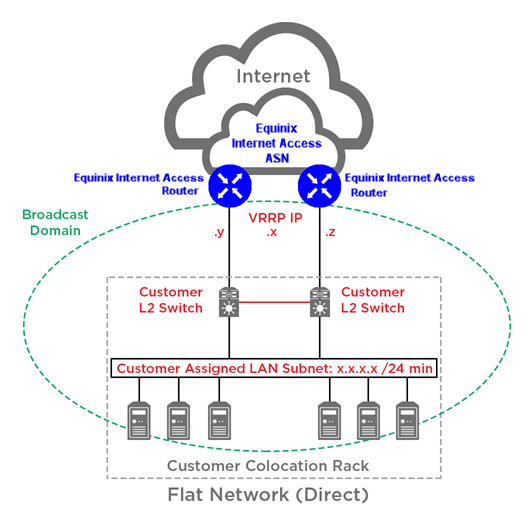Direct Routing
Direct Routing allows devices on a network to communicate with each other directly, without the need for intermediate routers. It is typically used in small networks where all devices are connected to the same network segment or subnet. Direct routing protocols do not involve complex routing algorithms or the exchange of routing information between devices. Instead, they rely on the devices' knowledge of the network topology and their ability to communicate directly with each other.
Direct Routing supports Virtual Router Redundancy Protocol (VRRP).
Single-Port Architectures
Single-Port Direct – Provider-assigned IP
This configuration uses a flat network, meaning there is no routed network. The default IP addresses assigned by Equinix are a /30 for IPv4 and a /64 for IPv6.
If you require more IP addresses for your LAN, you can purchase additional LAN IP subnets from Equinix.
To run Network Address Translation (NAT) or Port Address Translation (PAT), you must provide your own router or firewall as shown:

Single-Port Direct – Provider-independent IP
This configuration allows you to use your own public IP addresses for the LAN. Your subnets must be a minimum of /24 for IPv4 addresses or /48 for IPv6 addresses. You must also have created a Route Origin Authorization (ROA) in an IRR database as described in Provider Independent IP Space.
This example uses a /24 subnet:

Dual-Port Architectures
Dual-Port VRRP Direct – Provider-assigned IP
For this configuration, Equinix assigns a default /29 for IPv4 addresses and /64 for IPv6 addresses for your LAN subnet. The first three octets are reserved for Equinix, in this order: Equinix VIP, Equinix PRI, and Equinix SEC. The customer gateway points to the Equinix VIP.
Example:
| Network | 149.97.230.128/29 |
|---|---|
| Equinix VIP | 149.97.230.129 |
| Equinix PRI | 149.97.230.130 |
| Equinix SEC | 149.97.230.131 |
Protection switching is where your equipment switches based on monitoring hello messages. You must provide the multi-access network (Layer 2 switching) required for VRRP advertisements between the primary router and the client.
You must provide the switching network between your Layer 2 switches.
To run NAT or PAT, you must provide your own router or firewall behind your Layer 2 switches as shown:

Dual-Port VRRP Direct – Provider-independent IP
This configuration allows you to use your own public IP addresses for the LAN. Your subnets must be a minimum of /24 for IPv4 addresses or /48 for IPv6 addresses. You must also have created a Route Origin Authorization (ROA) in an IRR database as described in Provider Independent IP Space.
You must provide the switching network between your Layer 2 switches.
Protection switching is where your equipment switches based on monitoring hello messages. You must provide the multi-access network (Layer 2 switching) required for VRRP advertisements between the primary router and the client.
